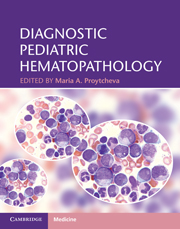Book contents
- Frontmatter
- Contents
- List of contributors
- Acknowledgements
- Introduction
- Section 1 General and non-neoplastic hematopathology
- 1 Hematologic values in the healthy fetus, neonate, and child
- 2 Normal bone marrow
- 3 Disorders of erythrocyte production
- 4 Disorders of hemoglobin synthesis
- 5 Hemolytic anemias
- 6 Inherited and acquired bone marrow failure syndromes associated with multiple cytopenias
- 7 Inherited bone marrow failure syndromes and acquired disorders associated with single peripheral blood cytopenia
- 8 Peripheral blood and bone marrow manifestations of metabolic storage diseases
- 9 Reactive lymphadenopathies
- Section 2 Neoplastic hematopathology
- Index
- References
5 - Hemolytic anemias
Immune- and non-immune-mediated hemolytic anemias, RBC membrane defects, and hereditary disorders due to RBC enzyme defects
from Section 1 - General and non-neoplastic hematopathology
Published online by Cambridge University Press: 03 May 2011
- Frontmatter
- Contents
- List of contributors
- Acknowledgements
- Introduction
- Section 1 General and non-neoplastic hematopathology
- 1 Hematologic values in the healthy fetus, neonate, and child
- 2 Normal bone marrow
- 3 Disorders of erythrocyte production
- 4 Disorders of hemoglobin synthesis
- 5 Hemolytic anemias
- 6 Inherited and acquired bone marrow failure syndromes associated with multiple cytopenias
- 7 Inherited bone marrow failure syndromes and acquired disorders associated with single peripheral blood cytopenia
- 8 Peripheral blood and bone marrow manifestations of metabolic storage diseases
- 9 Reactive lymphadenopathies
- Section 2 Neoplastic hematopathology
- Index
- References
Summary
Introduction
Hemolysis, the destruction of red blood cells, can be categorized based on the site of hemolysis (intravascular vs. extravascular), the relation to the red cell (intrinsic vs. extrinsic), or the pattern of onset (inherited vs. acquired) (Fig. 5.1). The severity of the clinical findings in hemolysis depends on many factors, which are discussed below (Table 5.1). It is important to determine the underlying cause of hemolysis since the medical management may be different.
Immune-mediated hemolytic anemias
Immune-mediated hemolytic anemias result from intravascular or extravascular hemolysis triggered by various intrinsic and extrinsic factors. While the intravascular hemolysis occurs predominantly in the blood vessels, the extravascular hemolysis, which accounts for most cases of hemolytic anemia, is due to elimination of red cells by phagocytes in the spleen, liver, and bone marrow. Activation of the classic complement cascade is the main pathogenetic mechanism leading to immune-mediated hemolysis. Certain classes of antibodies are more effective than others at activating complement (IgM > IgG3 > IgG1 > IgG2). More commonly, the red cell is coated with complement C3b and C3d, and, less frequently, the activation of the complement cascade leads to the formation of membrane attack complex and red cell lysis [1, 2]. Since the liver macrophages do not harbor a C3d receptor, the red cells are not prematurely destroyed. Different antibody classes mediate the hemolytic process differently.
- Type
- Chapter
- Information
- Diagnostic Pediatric Hematopathology , pp. 75 - 89Publisher: Cambridge University PressPrint publication year: 2011
References
- 1
- Cited by



